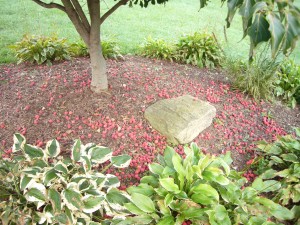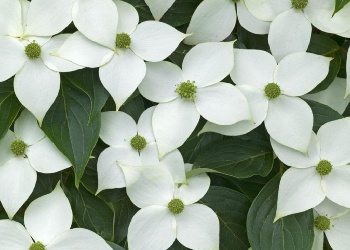Kousa Dogwood - Eat The Weeds and other things, too
The Kousa Dogwood is one of those plants that makes you ask: What is it?

Kousa dropping fruit in Boone North Carolina.
Its large, bumpy, red fruit looks like a raspberry on steroids. Very eye catching and exotic, which it is in North America. Planted as an ornamental reports say it is naturalized only in the New York city area. But I have personally seen it growing on its own from there south and west. You can also find it in protected or warmer areas farther north. Look for it in landscaping or as a potted plant. In the Carolinas, where I go for a busman’s holiday, it’s a common ornamental. In fact where I stay in Boone, North Carolina, there’s one at the bottom of the hill. In Ashville where I study mushrooms it’s an escapee. In late August it and the ground beneath it are covered with fruit.
The Kousa grows to 15 to 20 feet, has flakey bark, and long-lasting white “flowers” which usually come out about a month after its cousin, the Flowering Dogwood (
Cornus florida.) Actually, its flowers are quite small. The shrub’s showiness comes from large white bracts that dwarf the true flowers. The bracts are two to three inches across, sometime off-white to light yellow, and cover the entire tree when in bloom. Another reason why this Asian native is used in landscaping is as it matures the bark flakes leaving a camouflage pattern of tan and brown, sometimes tan and green. In autumn the leaves turn bronze before dropping.

Kousa Dogwood showy bracts
Kousa’s bracts can turn pink to red through the season, and the
Cornus kousa satomi starts with pink flowers that turn purple. In fact, there are nearly 100 different cultivars of the plant and it’s been in western gardens since 1875. The Kousa is also resistance to Dogwood Anthracnose, a fungal disease that has been infecting flowering dogwoods in eastern North America.
Although the fruit is pink to red, inside it is yellow to orange and has a taste people can’t agree on. Some say the texture similar to a pear or apricot. To me the pulp texture was like a ripe persimmon, the flavor like an apple. The tougher skin tasted like bitter peach. Usually it is eaten raw but can be cooked but doing so can destroy its delicate flavor. The fruit can also be made into jelly. As I said the skin can be tough and sometimes the fruit is bitter. The young leaves are cooked and eaten by mountain people in Japan. I have not tried said, so be wary. Additionally, the fruit may have anti-tumor activity. Read the Herb Blurb below. It ain’t easy…
Botanically
Cornus (KORE-nus) means “horn” which can mean a wind instrument or hard. The dogwood is known to make stiff skewers and dogwood is from Dag where we also get the word dagger.
Kousa (KOO-sah) is the Japanese name for the tree, It is also called
Benthamia kousa – (Miq.) Nakai, and
Benthamidia japonica (Siebold.&Zucc.) H.Hara.
Green Deane’s “Itemized” Plant Profile
IDENTIFICATION: Shrub or a small tree to 25 feet, camouflaged-patterned bark, tan and brown, leaves 2 to 4″ long, opposite, simple, dark green; reddish purple to scarlet to bronze fall color. Vase shaped when young growing into a rounded shape with horizontal branching.
TIME OF YEAR: Fruit in the fall, young leaves anytime present.
ENVIRONMENT: Well-drained soil, full sun to partial shade, usually in landscaping or potted.
METHOD OF PREPARATION: Ripe fruit edible raw. They can be made into jelly. Young leaves boiled.
HERB BLURB
20 May 2005, Life Sciences, Volume 78, Issue 7, pp 777-784: The anthocyanins in native
Cornus alternifolia, Cornus controversa, Cornus kousa and
Cornus florida were quantified by HPLC and characterized by spectroscopic methods. The analyses of
C. alternifolia and
C. controversa revealed that both contained delphinidin 3-O-glucoside (1), delphinidin 3-O-rutinoside (2) and cyanidin 3-O-glucoside (6), respectively. Similarly,
C. florida and
C. kousa showed identical anthocyanin profiles with major anthocyanins as cyanidin 3-O-galactoside (4) and cyanidin 3-O-glucoside (6), respectively. The amount of anthocyanins 1, 2 and 6 in
C. alternifolia and
C. controversa were 8.21, 8.44 and 0.02 mg; and 7.74, 5.92, and 0.02 mg/g of fresh fruits, respectively. The anthocyanins 4 and 6 in
C. kousa and C. florida were 0.02 and 0.16 mg; and 0.62 and 0.03 mg/g fresh fruits, respectively. Anthocyanins 1 and 2 were not studied earlier for their inhibition of lipid peroxidation, cyclooxygenase enzymes (COX-1 and COX-2), and tumor cell proliferation. At 50 μg/mL, anthocyanins 1 and 2 inhibited lipid peroxidation by 71% and 68%, respectively. Similarly, they inhibited COX-1 enzymes by 39% and 49% and COX-2 enzyme by 54% and 48%, respectively, at 100 μg/mL. Anthocyanin 1 displayed 50% growth inhibition (IC50) at 21, 25, 50, 60, and 75 μg/mL, against HCT-116 (colon), MCF-7 (breast), NCI-H460 (lung), SF-268 (central nervous system CNS), and AGS (stomach) human tumor cell lines, respectively. Similarly, IC50 values for anthocyanin 2 were 38, 30, 76, 100, and 100 μg/mL against HCT-116, MCF-7, NCI H460, SF-268, and AGS, respectively. This is the first report of the quantification and biological activities of anthocyanins in
C. alternifolia, C. kousa and
C. florida in addition to the anthocyanins not previously quantified in
C. controversa.




























































